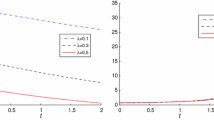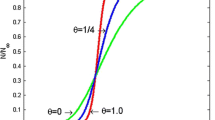Abstract
The rate at which a population should grow is determined by finding the best trade-off between the loss due to the deviation from a target population size and the loss associated to the growing effort. It is also shown that, in the case of infinite-time horizon and quadratic loss functions, the optimal growth is logistic.
Similar content being viewed by others
References
Verhulst, P. F., Recherches Mathématiques sur la Loi d'Accroissement de la Population, Memoirs de l'Academie Royale Belgique, Vol. 18, pp. 1–38, 1845 (in French).
Volterra, V.,Calculus of Variations and the Logistic Curve, Human Biology, Vol. 11, pp. 173–178, 1939.
Leitmann, G.,A Minimum Principle for a Population Equation, Journal of Optimization Theory and Applications, Vol. 9, pp. 155–156, 1972.
Author information
Authors and Affiliations
Additional information
Communicated by G. Leitmann
This research was supported by the Centro Teoria dei Sistemi, CNR, and by the Italian Ministry of Public Education.
Rights and permissions
About this article
Cite this article
Gatto, M., Muratori, S. & Rinaldi, S. On the optimality of the logistic growth. J Optim Theory Appl 57, 513–517 (1988). https://doi.org/10.1007/BF02346168
Issue Date:
DOI: https://doi.org/10.1007/BF02346168




